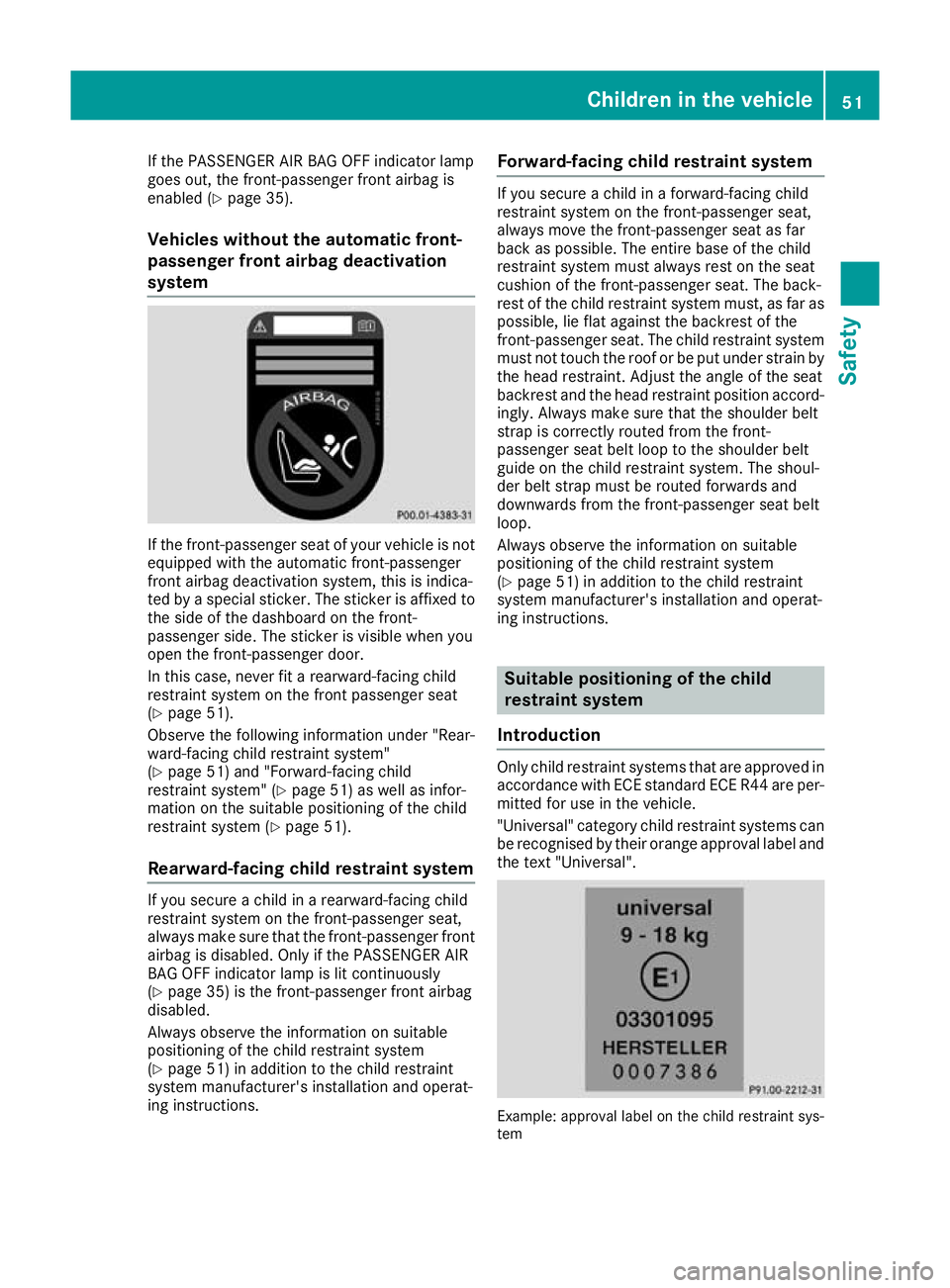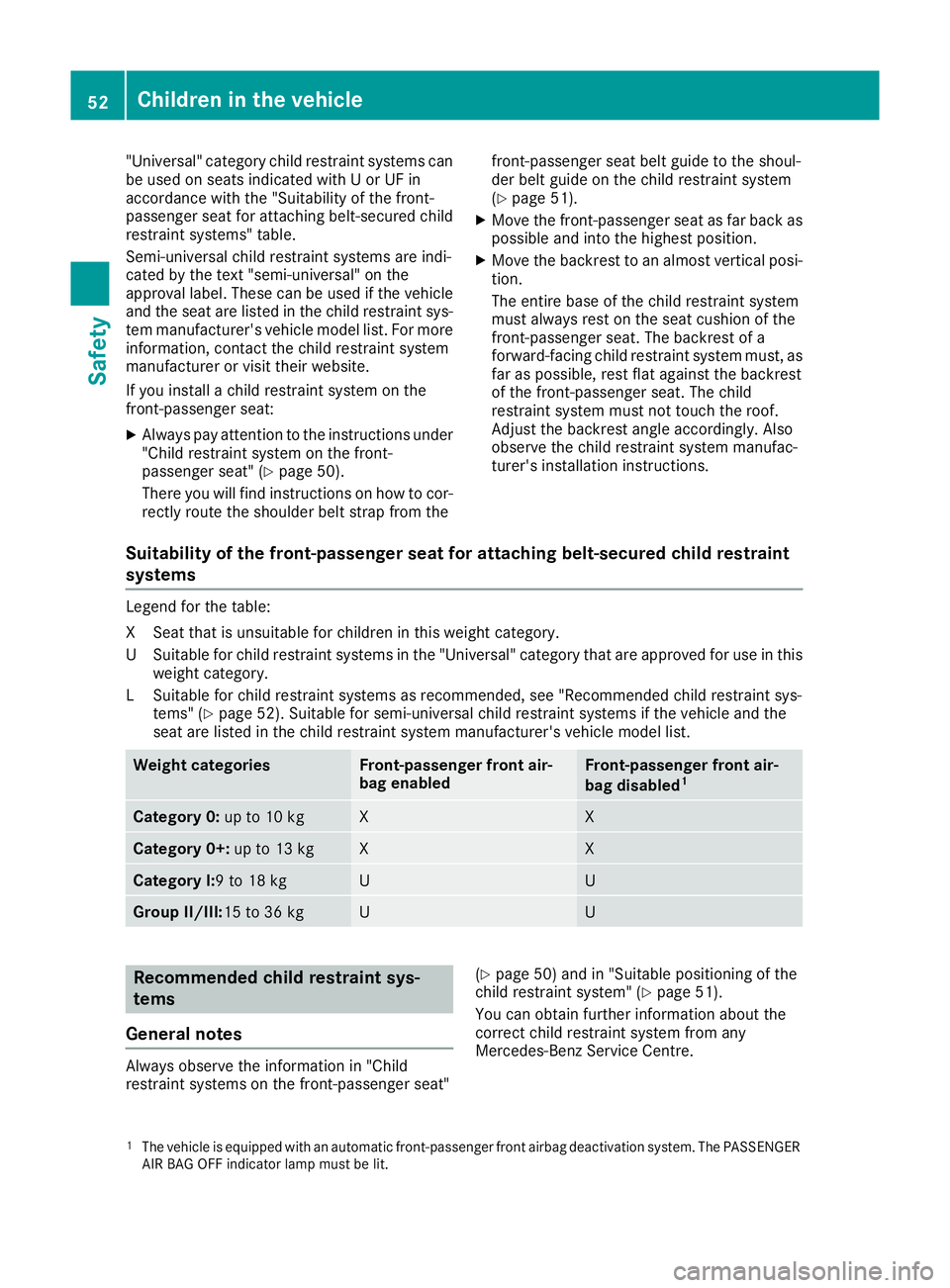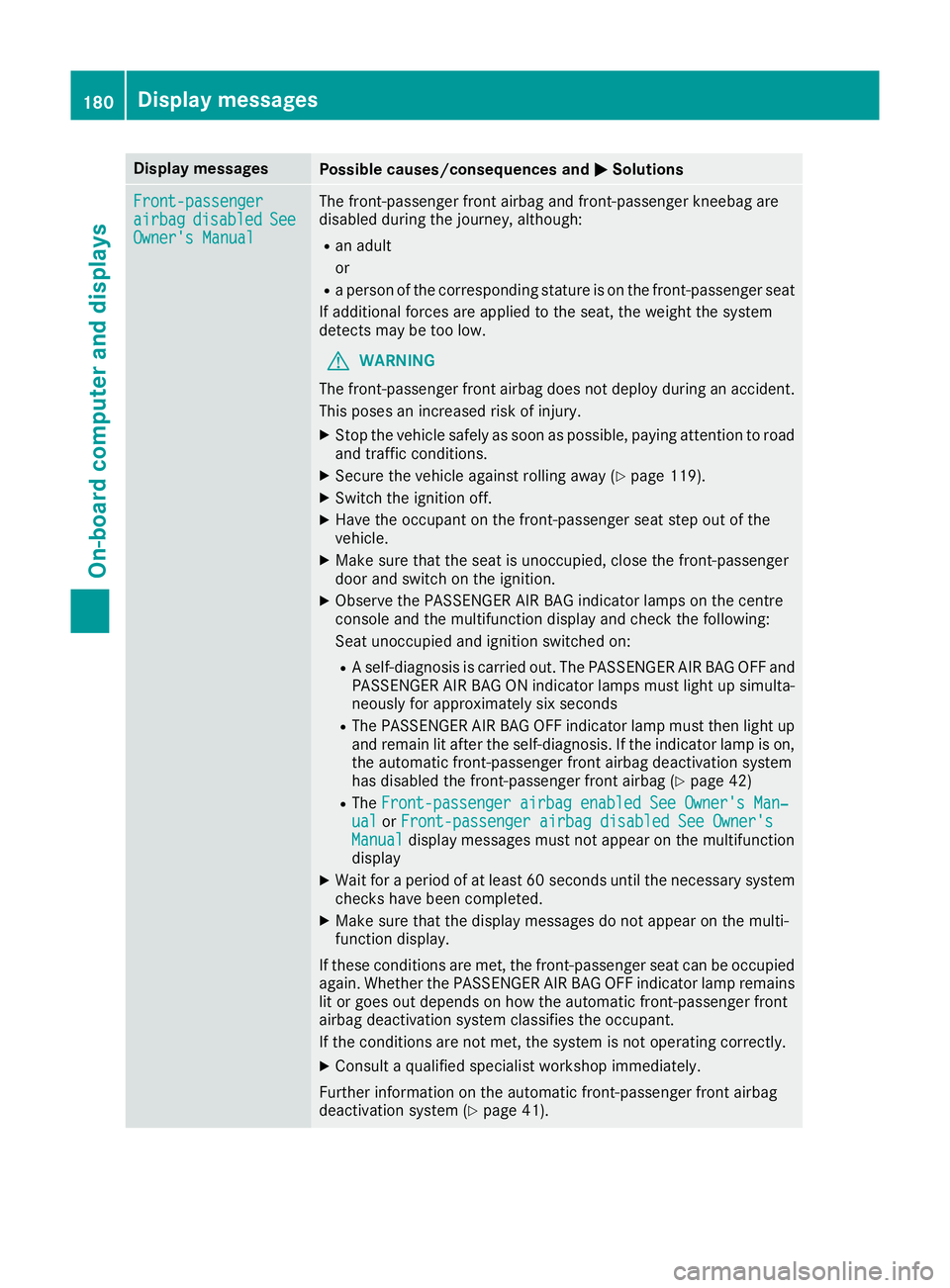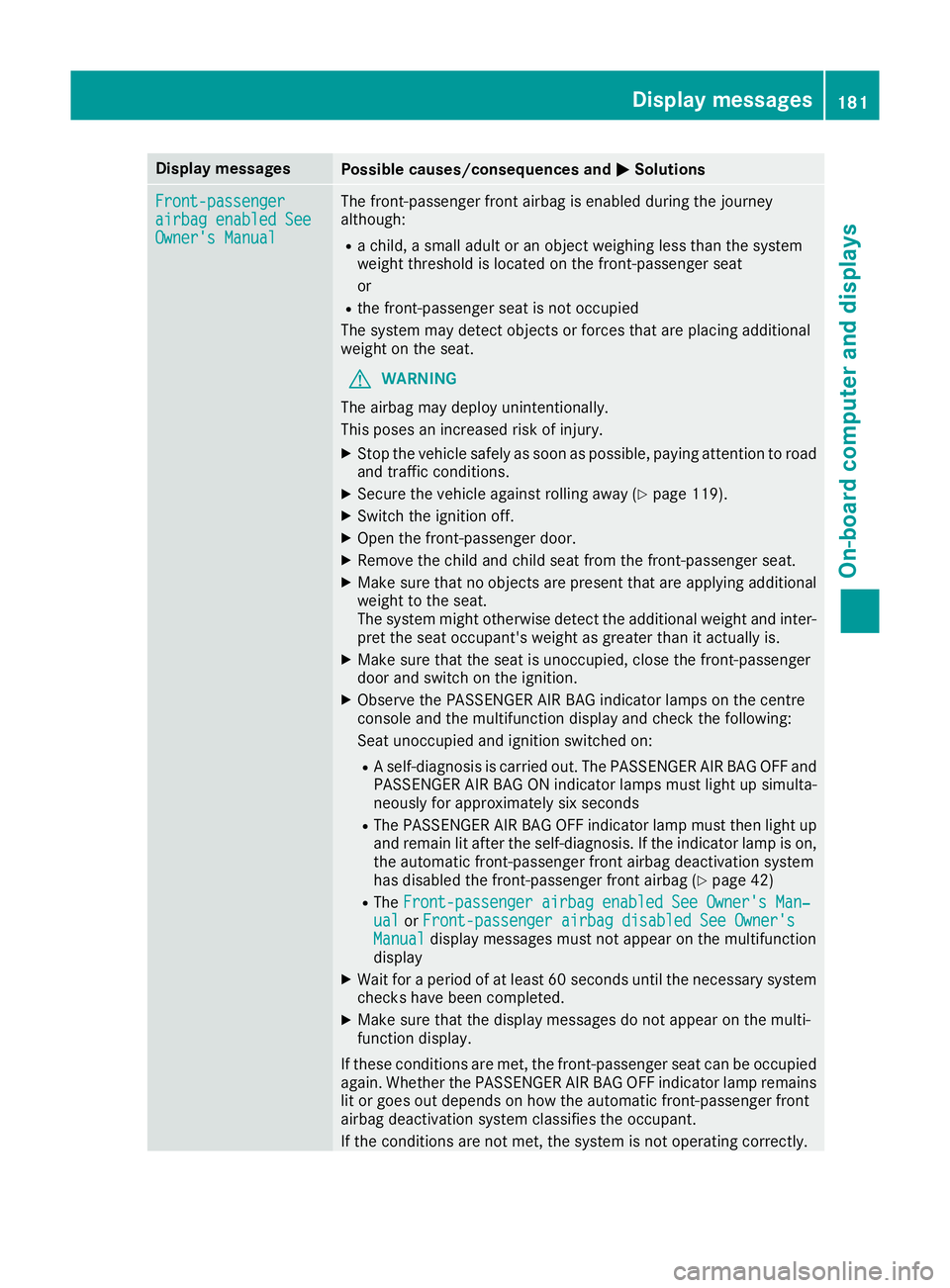2016 MERCEDES-BENZ AMG GT ROADSTER airbag disable
[x] Cancel search: airbag disablePage 54 of 289

If the PASSENGER AIR BAG OFF indicator lamp
goes out, the front-passenger front airbag is
enabled (Y page 35).
Vehicles without the automatic front-
passenger front airbag deactivation
system If the front-passenger seat of your vehicle is not
equipped with the automatic front-passenger
front airbag deactivation system, this is indica-
ted by a special sticker. The sticker is affixed to
the side of the dashboard on the front-
passenger side. The sticker is visible when you
open the front-passenger door.
In this case, never fit a rearward-facing child
restraint system on the front passenger seat
(Y page 51).
Observe the following information under "Rear-
ward-facing child restraint system"
(Y page 51) and "Forward-facing child
restraint system" (Y page 51) as well as infor-
mation on the suitable positioning of the child
restraint system (Y page 51).
Rearward-facing child restraint system If you secure a child in a rearward-facing child
restraint system on the front-passenger seat,
always make sure that the front-passenger front airbag is disabled. Only if the PASSENGER AIR
BAG OFF indicator lamp is lit continuously
(Y page 35) is the front-passenger front airbag
disabled.
Always observe the information on suitable
positioning of the child restraint system
(Y page 51) in addition to the child restraint
system manufacturer's installation and operat-
ing instructions. Forward-facing child restraint system If you secure a child in a forward-facing child
restraint system on the front-passenger seat,
always move the front-passenger seat as far
back as possible. The entire base of the child
restraint system must always rest on the seat
cushion of the front-passenger seat. The back-
rest of the child restraint system must, as far as
possible, lie flat against the backrest of the
front-passenger seat. The child restraint system must not touch the roof or be put under strain bythe head restraint. Adjust the angle of the seat
backrest and the head restraint position accord-
ingly. Always make sure that the shoulder belt
strap is correctly routed from the front-
passenger seat belt loop to the shoulder belt
guide on the child restraint system. The shoul-
der belt strap must be routed forwards and
downwards from the front-passenger seat belt
loop.
Always observe the information on suitable
positioning of the child restraint system
(Y page 51) in addition to the child restraint
system manufacturer's installation and operat-
ing instructions. Suitable positioning of the child
restraint system
Introduction Only child restraint systems that are approved in
accordance with ECE standard ECE R44 are per-
mitted for use in the vehicle.
"Universal" category child restraint systems can
be recognised by their orange approval label and the text "Universal". Example: approval label on the child restraint sys-
tem Children in the vehicle
51Safety Z
Page 55 of 289

"Universal" category child restraint systems can
be used on seats indicated with U or UF in
accordance with the "Suitability of the front-
passenger seat for attaching belt-secured child
restraint systems" table.
Semi-universal child restraint systems are indi-
cated by the text "semi-universal" on the
approval label. These can be used if the vehicle and the seat are listed in the child restraint sys-
tem manufacturer's vehicle model list. For more
information, contact the child restraint system
manufacturer or visit their website.
If you install a child restraint system on the
front-passenger seat:
X Always pay attention to the instructions under
"Child restraint system on the front-
passenger seat" (Y page 50).
There you will find instructions on how to cor-
rectly route the shoulder belt strap from the front-passenger seat belt guide to the shoul-
der belt guide on the child restraint system
(Y page 51).
X Move the front-passenger seat as far back as
possible and into the highest position.
X Move the backrest to an almost vertical posi-
tion.
The entire base of the child restraint system
must always rest on the seat cushion of the
front-passenger seat. The backrest of a
forward-facing child restraint system must, asfar as possible, rest flat against the backrest
of the front-passenger seat. The child
restraint system must not touch the roof.
Adjust the backrest angle accordingly. Also
observe the child restraint system manufac-
turer's installation instructions.
Suitability of the front-passenger seat for attaching belt-secured child restraint
systems Legend for the table:
XS
eat that is unsuitable for children in this weight category.
US uitable for child restraint systems in the "Universal" category that are approved for use in this
weight category.
LS uitable for child restraint systems as recommended, see "Recommended child restraint sys-
tems" (Y page 52). Suitable for semi-universal child restraint systems if the vehicle and the
seat are listed in the child restraint system manufacturer's vehicle model list. Weight categories Front-passenger front air-
bag enabled Front-passenger front air-
bag disabled
1 Category 0:
up to 10 kg X X
Category 0+:
up to 13 kg X X
Category I:9 to 18 kg U U
Group II/III:
15 to 36 kg U U
Recommended child restraint sys-
tems
General notes Always observe the information in "Child
restraint systems on the front-passenger seat" (Y
page 50) and in "Suitable positioning of the
child restraint system" (Y page 51).
You can obtain further information about the
correct child restraint system from any
Mercedes-Benz Service Centre.
1 The vehicle is equipped with an automatic front-passenger front airbag deactivation system. The PASSENGER
AIR BAG OFF indicator lamp must be lit. 52
Children in the vehicleSafety
Page 183 of 289

Display messages
Possible causes/consequences and
M
MSolutions Front-passenger
Front-passenger
airbag airbag
disabled
disabled See
See
Owner's Manual
Owner's Manual The front-passenger front airbag and front-passenger kneebag are
disabled during the journey, although:
R an adult
or
R a person of the corresponding stature is on the front-passenger seat
If additional forces are applied to the seat, the weight the system
detects may be too low.
G WARNING
The front-passenger front airbag does not deploy during an accident.
This poses an increased risk of injury.
X Stop the vehicle safely as soon as possible, paying attention to road
and traffic conditions.
X Secure the vehicle against rolling away (Y page 119).
X Switch the ignition off.
X Have the occupant on the front-passenger seat step out of the
vehicle.
X Make sure that the seat is unoccupied, close the front-passenger
door and switch on the ignition.
X Observe the PASSENGER AIR BAG indicator lamps on the centre
console and the multifunction display and check the following:
Seat unoccupied and ignition switched on:
R A self-diagnosis is carried out. The PASSENGER AIR BAG OFF and
PASSENGER AIR BAG ON indicator lamps must light up simulta-
neously for approximately six seconds
R The PASSENGER AIR BAG OFF indicator lamp must then light up
and remain lit after the self-diagnosis. If the indicator lamp is on,
the automatic front-passenger front airbag deactivation system
has disabled the front-passenger front airbag (Y page 42)
R The Front-passenger airbag enabled See Owner's Man‐
Front-passenger airbag enabled See Owner's Man‐
ual ual orFront-passenger airbag disabled See Owner's
Front-passenger airbag disabled See Owner's
Manual
Manual display messages must not appear on the multifunction
display
X Wait for a period of at least 60 seconds until the necessary system
checks have been completed.
X Make sure that the display messages do not appear on the multi-
function display.
If these conditions are met, the front-passenger seat can be occupied again. Whether the PASSENGER AIR BAG OFF indicator lamp remains lit or goes out depends on how the automatic front-passenger front
airbag deactivation system classifies the occupant.
If the conditions are not met, the system is not operating correctly.
X Consult a qualified specialist workshop immediately.
Further information on the automatic front-passenger front airbag
deactivation system (Y page 41).180
Display
messagesOn-board computer and displays
Page 184 of 289

Display messages
Possible causes/consequences and
M
MSolutions Front-passenger
Front-passenger
airbag enabled See airbag enabled See
Owner's Manual Owner's Manual The front-passenger front airbag is enabled during the journey
although:
R a child, a small adult or an object weighing less than the system
weight threshold is located on the front-passenger seat
or
R the front-passenger seat is not occupied
The system may detect objects or forces that are placing additional
weight on the seat.
G WARNING
The airbag may deploy unintentionally.
This poses an increased risk of injury. X Stop the vehicle safely as soon as possible, paying attention to road
and traffic conditions.
X Secure the vehicle against rolling away (Y page 119).
X Switch the ignition off.
X Open the front-passenger door.
X Remove the child and child seat from the front-passenger seat.
X Make sure that no objects are present that are applying additional
weight to the seat.
The system might otherwise detect the additional weight and inter-pret the seat occupant's weight as greater than it actually is.
X Make sure that the seat is unoccupied, close the front-passenger
door and switch on the ignition.
X Observe the PASSENGER AIR BAG indicator lamps on the centre
console and the multifunction display and check the following:
Seat unoccupied and ignition switched on:
R A self-diagnosis is carried out. The PASSENGER AIR BAG OFF and
PASSENGER AIR BAG ON indicator lamps must light up simulta-
neously for approximately six seconds
R The PASSENGER AIR BAG OFF indicator lamp must then light up
and remain lit after the self-diagnosis. If the indicator lamp is on, the automatic front-passenger front airbag deactivation system
has disabled the front-passenger front airbag (Y page 42)
R The Front-passenger airbag enabled See Owner's Man‐
Front-passenger airbag enabled See Owner's Man‐
ual ual orFront-passenger airbag disabled See Owner's
Front-passenger airbag disabled See Owner's
Manual
Manual display messages must not appear on the multifunction
display
X Wait for a period of at least 60 seconds until the necessary system
checks have been completed.
X Make sure that the display messages do not appear on the multi-
function display.
If these conditions are met, the front-passenger seat can be occupied again. Whether the PASSENGER AIR BAG OFF indicator lamp remains
lit or goes out depends on how the automatic front-passenger front
airbag deactivation system classifies the occupant.
If the conditions are not met, the system is not operating correctly. Display
messages
181On-board computer and displays Z